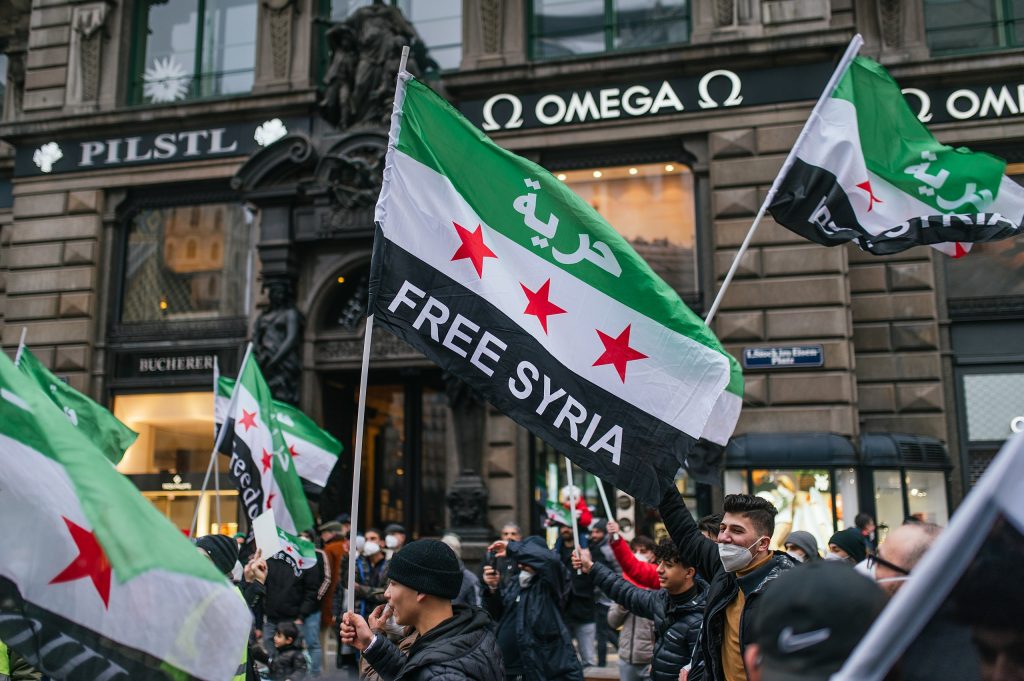From the May-June 2021 issue of News & Letters
by Gerry Emmett
It has been said, “The Revolution is an idea; you can’t kill an idea.” The thousands who gathered in Idlib city on March 15, the 10th anniversary of the beginning of the Syrian Revolution, lived that truth.

Protesters on Feb. 21, 2021, in Vienna, Austria, demanding a “Free Syria!” Photo: Ivan Radic.
There were no illusions. The half million dead, tens of thousands still detained and tortured, and 12 million displaced make illusions impossible. One banner read: “A decade of global abandonment.”
Yet as Hana Dahneen told reporters, “We came to renew the pledge we made in 2011 when we decided to oust Assad.” She spoke for the large crowd singing “Freedom, freedom, freedom!”
Ghazala al-Saeed, displaced from his village, said “We came to send a message that we are continuing our revolution, the Revolution of Dignity, the Revolution of the Detainees. We demand the right to a safe return without the Assad regime and the release of the detainees from prison.”
FREEDOM IS THE ESSENCE OF HUMANITY
A group of artists contributed their work to the gathering, declaring that “a cry for freedom from a person is the cry of freedom for which the revolution was launched.” Their mural depicted, among scenes of the revolution, a man bandaged but unbroken, still uttering that cry.
The philosopher Hegel would say these revolutionaries are aware of freedom as their essence, aim, and object. Freedom, not as something that they have, but freedom as what they are, as human beings.
Hegel would say that this truth demands a real world development. That is easier to understand if one thinks of the Syrian Revolution in its original context of the Arab Spring. It was clear that revolutionaries in Egypt, Palestine, Bahrain, Libya, saw their struggles as deeply connected.
Likewise, at least some of us in the Occupy movement held on to the revelation we received from experiencing the unity between Madison, Wisc., and Tahrir Square.
Homs and Kafranbel, though distant, became more real than our own yesterdays. No wonder the powers of the earth trembled, then lashed out or cravenly betrayed.
RESISTANCE TO ASSAD (ETC.) CONTINUES
It has been said, “We thought we were fighting Assad, then we realized we were fighting the world.”
In the “cradle of the revolution,” Daraa, occupied by Russia, a low-level insurgency continues, with attacks on Assad’s military and police functionaries. There remains a smoldering opposition often openly expressed. It still exists among many Druze in Suwayda, as well as in the eastern region now occupied by the U.S. military.
Further, countless Free Syrians in exile have remained active in the struggle.
THE IDEA OF FREEDOM LIVES
The idea of Free Syria hasn’t been killed. What it has become is, again to borrow from the philosopher, a manifestation of the “world spirit” more profound than what Hegel thought he witnessed at Jena in 1806. Napoleon met his Waterloo in 1815 and faded.
The Syrian Revolution is more akin to the Paris Commune of 1871, a collective act that becomes a category of thought, of reason, necessary for the self-understanding of humanity, and the comprehension of history.
Recall the banner Free Syrians raised at Kafranbel in 2014: “If you are human, you have to care for the Syrian people. If you are human, support us to bring Assad down.”
If humanity is ever to become free and self-determining, it will only be through grasping the significance of these historic acts, with their suffering that judges the world, and their endless openness to a more creative, humane future.
